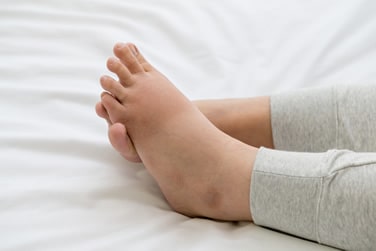 Swelling (edema), occurs when excessive amounts of fluid leak from small capillaries into tissues of the feet, ankles and lower legs.
Swelling (edema), occurs when excessive amounts of fluid leak from small capillaries into tissues of the feet, ankles and lower legs.
Obesity, pregnancy, venous insufficiency, certain medications, a salty diet, standing or sitting too much while working, a compromised immune system, or underlying medical conditions can all cause this swelling to take place.
Symptoms Often Associated with Edema
Besides swelling, there are several symptoms someone with edema may also experience which may affect their quality of life, including:
- Pain
- Soreness
- Tightness
- Skin that is red, shiny, or feels stretched
Sometimes swelling in the skin is accompanied by pitting. This is when an impression remains in the skin for a period of time after it is pressed on by your podiatrist’s finger. They will grade the level of pitting (from 1-4) by how deep the impression is and how long it lasts.
You should seek emergency care if you experience symptoms such as shortness of breath, swelling that comes on quickly while you are pregnant, swelling in just one foot, or feeling as if you may have a blood clot.
How Podiatrists Treat Swelling in the Lower Extremities
Your podiatrist has many ways to help alleviate your swelling and other symptoms, which will vary depending on its severity, and what the underlying cause is. They will also offer additional advice on how to prevent edema from reoccurring. These techniques and tips may include:
- Wearing compression socks
- Increasing water intake
- Taking certain medications
- Changing choice of shoes
- Keeping the feet elevated as much as possible
- Cutting back on salt
- Doing gentle exercises
If you are experiencing any swelling in the feet, ankles or legs, make an appointment with your podiatrist as soon as possible.
